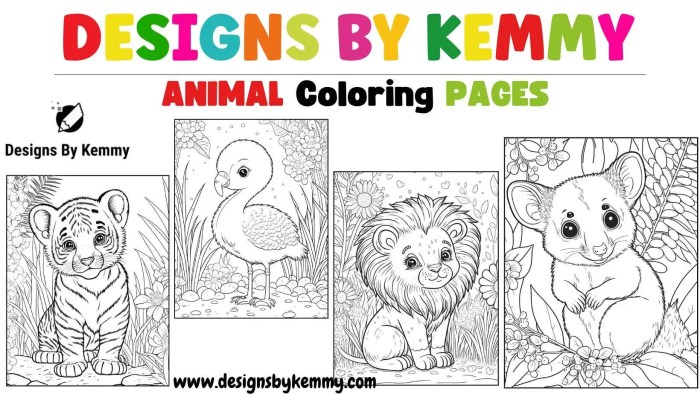Content and Features of Popular Coloring Pages: Free Baby Animals Coloring Pages

Free baby animals coloring pages – Yo, check it. Free baby animal coloring pages are a massive vibe, right? They’re not just about crayons and creativity; they’re a gateway to learning and fun. Let’s break down what makes ’em tick.Popular free baby animal coloring pages generally share a few key features that make them appealing to both kids and parents. These elements contribute to their widespread popularity and effectiveness as both entertainment and educational tools.
Common Features of Popular Designs
Five common features frequently found in successful free baby animal coloring pages are simple line art, large colorable areas, bright and cheerful color palettes, engaging animal poses, and clear Artikels. Simple line art makes it easy for young children to color within the lines, while large colorable areas provide ample space for creative expression without overwhelming them. Bright colors stimulate visual interest and the choice of appealing animal poses – think playful cubs or curious kittens – increases engagement.
Clear Artikels ensure the images are easily identifiable and prevent frustration.
Age Range and Design Choices, Free baby animals coloring pages
The age range these designs typically cater to is broadly 2-6 years old. Simpler designs, with fewer details and larger spaces, are geared towards the younger end of this spectrum (2-4 years). Older children (4-6 years) can handle more intricate details and smaller spaces, allowing for greater creativity and fine motor skill development. For example, a coloring page of a single, large panda cub with bold Artikels would suit a younger child, while a page featuring a family of monkeys interacting in a tree, with more detailed features, would be more appropriate for an older child.
Types of Baby Animals Depicted
The types of baby animals depicted are incredibly diverse. Common choices include kittens, puppies, panda cubs, baby elephants, and lion cubs. Less common but still popular choices might include baby sloths, red pandas, meerkats, or even baby penguins. The variety ensures a broad appeal and introduces children to a wider range of animals. The inclusion of less common animals also sparks curiosity and can inspire further learning.
Subtle Incorporation of Educational Elements
Educational elements can be subtly woven into the design. For example, a coloring page of a baby giraffe could include a small, unobtrusive fact box featuring a simple sentence like, “Baby giraffes are called calves!” or a picture showing the height of a baby giraffe next to an adult. Similarly, a coloring page of a baby polar bear could include a tiny image of a snowflake and the words “Polar bears live in the Arctic.” This approach avoids overwhelming the child with text while providing valuable, age-appropriate information.
Free baby animals coloring pages offer a delightful activity for young children, fostering creativity and fine motor skills. Expanding this theme, parents might also consider resources like coloring sheets farm animals , which provide similar benefits and introduce children to a wider range of animal species. Returning to the initial focus, the wide availability of free baby animals coloring pages ensures accessibility for all families wishing to engage in this enriching pastime.
